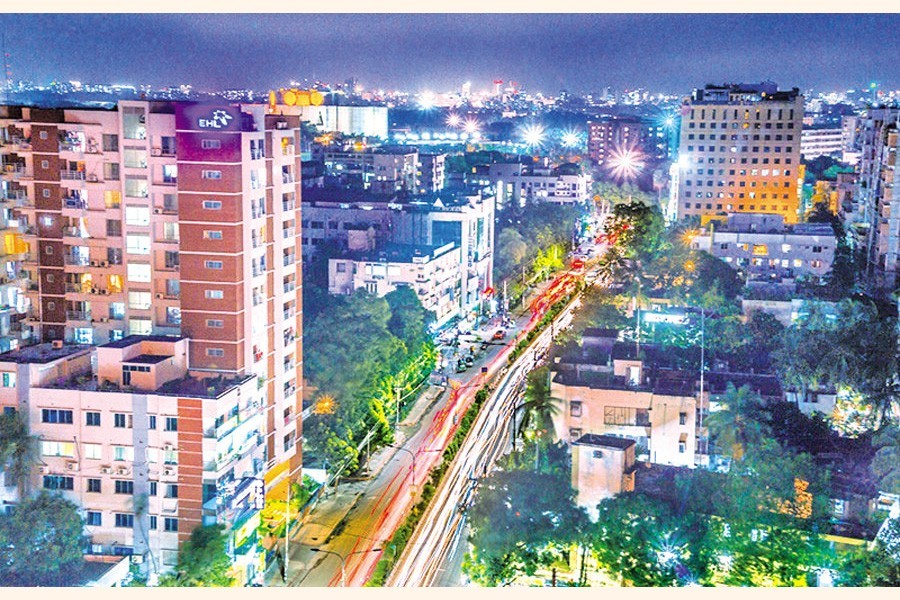Many neighbourhoods in Dhaka once gave the looks of their upscale counterparts in the developed cities. The spectacle was real hard to come by in other parts of the capital. Depressingly, parts of Dhanmondi Residential Area (R/A) have started giving the looks of the densely populated Rajabazar or Shahjahanpur today. In fact the residential areas of Dhanmondi, both old and new, used to be once considered exclusive to low-height residential buildings. These areas also included parts of Elephant Road, Eskaton, Azimpur and Lalmatia in 'New Dhaka'. On the other hand,Wari Rankin Street, Hatkhola, Gandaria etc in the city's older part stood exclusively, betraying their respective area-based elegance. So were the vast areas of Banani, Gulshan or Baridhara.
Being limited to the operation of office buildings of embassies and the residences of foreign diplomats, the city custodians of the vast area of Gulshan-Baridhara have to remain ever vigilant about keeping the required quiet of the diplomatic zone. Apart from police posts at intervals on the roads leading to the vast area, transport and pedestrian movements remain under the surveillance of close-circuit cameras. The vast Basundhara housing complex is also such an area.
The dominant feature that distinguishes many of these areas nowadays is population density. Shabby business outlets, pseudo-medical, or coaching centres add to this scourge. Clinics, pathological centres, local 'sports clubs' and similar outlets are now common spectacles in these areas. This writer was stunned to find two tailoring houses standing side by side, a males' hairdresser, a beauty parlour, and even a 'mudir dokan', in evidently quiet areas in Lalmatia and Dhanmondi. Vendors of all kinds were once strictly barred from entering these areas. Nowadays, they are common sights. Some hawkers calling out at the potential clients living on the higher floors use battery-run bullhorns. One can receive myriad types of service from these vendors. Those range from repair of gas burners, purchase of discarded laptops, mobile phones, to computer monitors etc.These vendors once would be frequently seen in the relatively older residential enclaves. Nowadays they are common sights in the exclusive residential areas.
According to experts specialising in Dhaka's urban evolution, it is the nouveaux richeswho should be blamedfor the major changes in these areas' environs. The situation has declined to such an extent that on occasions one finds it hard to tell the once upscale northern Dhanmondi neighbourhoods from the crammed localities in areas like Nimtoli, Siddheshwari or Nayatola. A noticeable development in Dhaka's once-famed residential areas is there are few citizens who can confidently approach the authorities to enforce a ban there on constructing high-rise condominiums, shopping malls, private universities, etc. But these structures continue to be built. In a fast expanding city, unabated constructions are a foregone conclusion. Long time ago, especially in the late fifties and sixties, the whole Dhaka town was so spacious and peaceful! The brick-wall- and-tin-roof dwellings used to dominate the vast expanses of residential areas. There were large and medium-size trees lining the narrow neighbourhood roads.
One could come across ponds and low marshlands at intervals. In the rainy season, the croaks of different sizes of frogs and insect chirps would filll the air. Thescreaming of foxes inside the Science Laboratory bushes in the late evenings used to create a pristineatmosphere in the fast-growing city.
Back then the Dhanmondi area had yet to see the full-scale construction spree. Moreover, a ban on constructing even 2-storey buildings had still been in place. Roads were moderately spacious, with a transparent lake flowing across the whole Dhanmondi Residential Area. Back then the sprawling Banani and Gulshan were dense jungles. As Dhaka, country’s largest urban centre, had witnessed a fast pace of growth with that of its economy, few bothered about the city's livability. The next generations may now have to pay the price, quite heavily at that.


